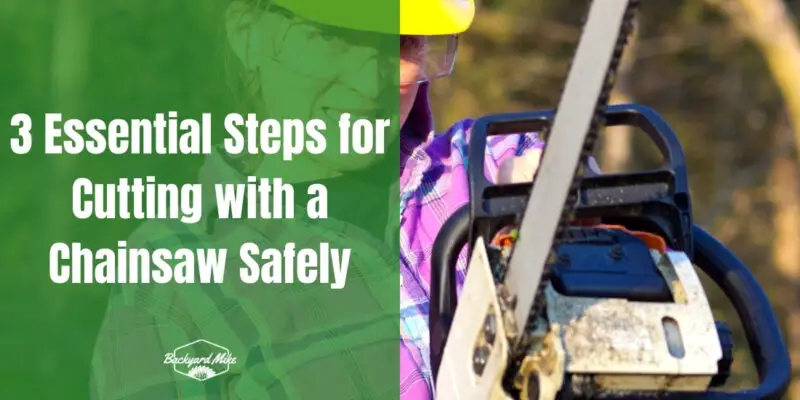To cut safely with a chainsaw, first clear your work area, removing obstacles and marking hazards for safety. Next, inspect your equipment, ensuring the chain tension is correct and safety features are functional. Don't forget to wear essential protective gear like a safety helmet, boots, gloves, and cut-resistant clothing. Adopt safe cutting practices by maintaining a balanced stance and keeping cuts below shoulder height. There's more to explore on executing chainsaw tasks efficiently and safely.
Key Takeaways
- Inspect the chainsaw for sharpness, oil levels, and functional controls before use.
- Wear protective gear, including a chainsaw helmet, cut-resistant clothing, and safety boots.
- Clear the work area of obstacles and identify potential hazards like electrical lines.
- Use both hands to grasp the chainsaw firmly, keeping the left thumb under the handle.
- Maintain a safe distance from others and avoid cutting above shoulder height.
Preparing the Work Area and Equipment
Before you start cutting with a chainsaw, it's essential to prepare your work area and equipment thoroughly.
Begin by clearing obstacles like small limbs, rocks, and dirt from your path to guarantee safe footing. Identify potential hazards, such as electrical lines and dangerous branches, marking the work area clearly to prevent unauthorized entry. Ensure that other workers are positioned at least twice the height of the trees being felled. It's crucial to look out for hangers and widow-makers—branches that may fall from above—when assessing potential hazards.
Clearing obstacles and identifying hazards ensures safe footing and prevents unauthorized entry in the work area.
Next, conduct a detailed equipment inspection. Check the chain tension and sharpness, confirming they're ideal for safe operation. Verify that oil levels are sufficient for lubrication, and confirm all controls, bolts, and the chain brake are functioning correctly. It is also important to consider the safety features of the chainsaw, such as anti-kickback chains and anti-vibration systems, which can significantly reduce the risk of accidents.
This careful preparation fosters a safe, efficient, and inclusive environment for everyone involved.
Wearing the Right Protective Gear
When operating a chainsaw, wearing the right protective gear is vital for your safety. Start with protective headgear, such as a chainsaw safety helmet that shields you from falling debris. Look for helmets with integrated ear protection muffs, face shields, and visors for full coverage. Confirm your helmet is inspected regularly. For body apparel, choose a chainsaw safety jacket or long-sleeved shirt made from cut-resistant materials. These garments should fit well, with closed seams to prevent accidents. Safety boots with reinforced toes and cut-resistant materials are essential for foot protection, and opt for soles that provide excellent grip. It is also important to consider high-quality fabrics which enhance durability and protection. Finally, gloves made from leather or synthetic blends protect your hands and guarantee a secure grip on the saw. To further ensure safety, consider using chainsaw chaps, which are specifically designed to resist chainsaw impact and reduce injury severity.
Executing Safe Cutting Practices
Grasp the chainsaw firmly with both hands, ensuring your thumbs and fingers are wrapped completely around the handles for a secure grip. This positioning is essential for kickback prevention. Keep your left thumb under the front handle to further reduce kickback impact. Stand with feet apart, left foot slightly ahead, to maintain balance and control. Always hold the saw close to your body, and avoid cutting above shoulder height. Implement effective cutting techniques by using crosscuts and rip cuts appropriately, and focus on using the main body of the guide bar. Chainsaw safety features, such as chain brakes and low kickback technology, are crucial in minimizing the risk of accidents. Keep others at least 3 to 5 meters away, and check the chainsaw's condition regularly. Avoid working alone by ensuring you have a transport vehicle accessible in case of emergencies.
Frequently Asked Questions
How Do I Handle a Chainsaw Kickback Safely?
You've got this! To handle chainsaw kickback safely, grip firmly with both hands, guarantee proper chain maintenance, and engage the chain brake. Focus on kickback prevention and safe operation, wearing safety gear to feel confident and secure.
What Should I Do if the Chainsaw Chain Gets Stuck?
When your chainsaw chain gets stuck, channel your inner hero. Turn off the engine, assess the situation carefully, and use tools for chain removal. Guarantee safety and precision, and you'll conquer the stuck chainsaw challenge together.
How Often Should I Sharpen the Chainsaw Chain?
You should sharpen your chainsaw chain regularly to guarantee efficient performance. Good chain maintenance involves using proper sharpening techniques. Aim to sharpen after every tank of fuel or whenever you notice decreased cutting efficiency and increased vibration.
What Is the Best Way to Fuel a Chainsaw Safely?
Fueling a chainsaw is like nurturing a fire; it's essential to choose the right fuel types and mixing ratios. You'll guarantee safety and precision, feeling connected to a community that values skillful, responsible chainsaw operation.
How Can I Store a Chainsaw to Prevent Damage?
To prevent damage, guarantee chainsaw maintenance by cleaning and draining fuel. Use storage solutions like a dry, secure area, and keep it upright. Protect it from moisture and sunlight, and perform regular inspections for reassurance.
Conclusion
To guarantee a smooth operation with your chainsaw, start by preparing your work area and equipment, making sure everything's in its place. Next, don your protective gear, as safety always takes center stage. Finally, practice safe cutting techniques, keeping a steady hand and a clear mind. By following these steps, you'll handle your chainsaw chores with ease and confidence. Remember, a little preparation goes a long way in guaranteeing both safety and efficiency.


